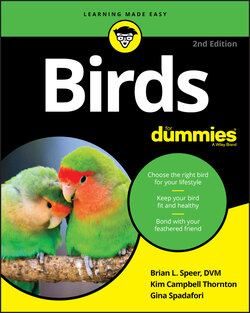Читать книгу Birds For Dummies - Gina Spadafori - Страница 71
The problem with unweaned birds
ОглавлениеBaby birds come in two varieties: weaned and unweaned. Weaned is a term for a bird who can eat on her own, instead of relying on parent birds or human surrogates to feed her. (When humans assume the duties of parent birds, they’re hand-feeding.) Fully weaned baby parrots are able to maintain their weight on their own for at least two weeks after the last hand-feeding. Regardless, these functionally weaned kids still have a lot of life lessons to get under their feathered belts, and they’re far from a “finished product.”
We do not recommend buying an unweaned bird. Some folks believe that bringing an unweaned bird into their hearts and homes is the best way to end up with a strongly bonded pet. Others push the economic aspect of such a purchase: Because the buyer takes over the round-the-clock work of hand-feeding, the cost of an unweaned bird is usually less. To put it bluntly: A dead or dying baby bird can’t bond with you, making her something less than a bargain. Too many things can go wrong when novices attempt to hand-raise a bird.
Take the typical blue-and-gold macaw baby, who crawls out of the egg weighing less than an ounce. That baby gains more than 30 times her body weight in the first eight weeks if properly fed and cared for. And “properly fed and cared for” usually means feeding every two hours, especially during the first couple of weeks of life. Experienced hand raisers can feed on autopilot. They fall out of bed, warm the formula, feed the babies, and go back to bed without ever really waking up.
When a novice tries hand-feeding while half-asleep, however, the lack of experience can really hurt. Formula can be overheated, burning the baby bird’s food-storage organ, called the crop. Formula can be fed too fast, flooding down the windpipe and into the bird’s lungs. The brooder where she’s kept can be too cold or too hot for the true needs of the baby — weakening her and setting the stage for other problems to develop.
A baby can die, very easily, from your mistakes, leaving you at 2 a.m. feeling like a bird murderer, all alone with no one to call for help. Don’t put yourself through the pain, and please try not to put any baby bird through the torture. Brian all too often performs postmortem examinations on baby birds from these settings to pinpoint the reason they died. We strongly suggest leaving the baby raising to folks who know what they’re doing.
If, after having birds for a while, you decide you want to go the breeder route, you certainly need to learn how to hand-feed babies. Turn to Chapter 13 to discover more about the joys and challenges of being a bird breeder and the thrills and chills of hand-raising bird babies of your own. Although Brian admits that the excitement, satisfaction, and fulfillment of successfully raising baby birds is immense, he also warns that the endeavor of bird breeding is not an easy one and is certainly not for everyone.
